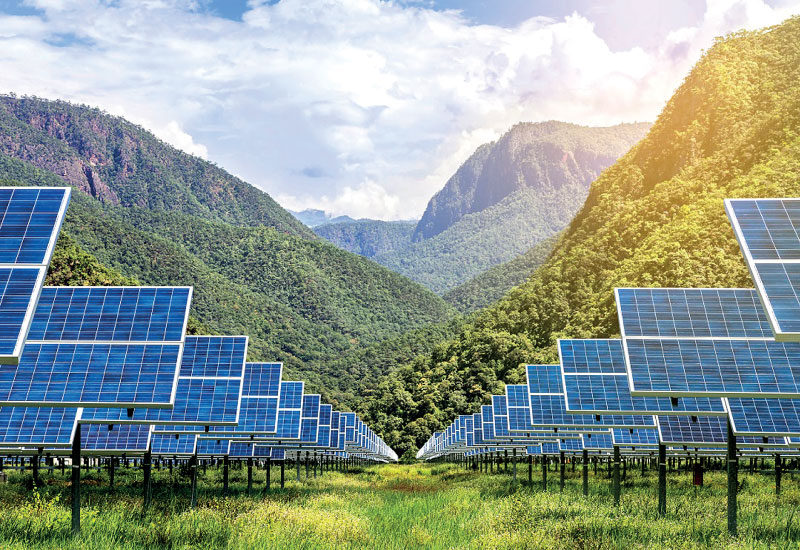Saturday Dec 27, 2025
Saturday Dec 27, 2025
Monday, 19 May 2025 01:29 - - {{hitsCtrl.values.hits}}

Energy or investments from a given energy plant is not the end goal – human wellbeing, national resilience, and sustainable prosperity are
|
 The recent article published, 7 May 2025 in Daily FT Sri Lanka, under the title “Wind power: Essential element of renewable energy mix for Sri Lanka,” shared by Mayura Botejue (a.k.a. ‘MB’), makes a passionate case for the primacy of wind in Sri Lanka’s renewable energy transition. While MB certainly raises some valid points “in general” however, on the other hand, his well-written piece clearly omits critical nuances required for a holistic understanding of not only Sri Lanka’s energy but most importantly the economic, agricultural, and ecological realities of an island where over a third of Sri Lankans are still deprived of basic needs even in 2025 as per the recent World Bank report issued.
The recent article published, 7 May 2025 in Daily FT Sri Lanka, under the title “Wind power: Essential element of renewable energy mix for Sri Lanka,” shared by Mayura Botejue (a.k.a. ‘MB’), makes a passionate case for the primacy of wind in Sri Lanka’s renewable energy transition. While MB certainly raises some valid points “in general” however, on the other hand, his well-written piece clearly omits critical nuances required for a holistic understanding of not only Sri Lanka’s energy but most importantly the economic, agricultural, and ecological realities of an island where over a third of Sri Lankans are still deprived of basic needs even in 2025 as per the recent World Bank report issued.
It is important to understand, Sri Lanka’s path forward with “renewable energy” must be based not just on potential megawatts or the immediate FDI monetary value the Government would receive to the country through local projects initiations as a short-term quick fix to increase foreign reserves in the country, but rather on long-term practical integration, socio-economic synergy, environmental preservation, climate resilience and most importantly the sustainability of these projects impacting the overall livelihoods and wellbeing of the present as well as future generations to come.
In this context, Noteworthy Global coming from a team of international professionals with ancestral Sri Lankan roots stands firm in unity on our ground on the value preposition we bring with regard to the wellbeing of Sri Lankan Future presenting the Sri Lankan Government – solar power – predominantly through “Agrivoltaic Systems” – to provide a more feasible, equitable, and sustainable path than wind with the currently on-going discussions with ministerial officials in Sri Lanka on the same.
1. Wind power in Sri Lanka: Not without complications and long-term impacts
MB rightly notes that Sri Lanka has a theoretical wind potential of 20-24 GW. While numbers in theory is nice, the practical and economic feasibility of tapping into this potential is severely limited. According to the Sustainable Energy Authority (SEA), only around 5 GW is technically exploitable due to land use restrictions, ecological constraints, and variability in wind resources.
Moreover, the centralised nature of wind farms demands large tracts of contiguous land – a rare commodity in an island nation like Sri Lanka with an already high population density and competing land demands unlike the New Zealand or Australia.
2. Economic and grid realities
Wind power is intermittent and demands heavy grid stabilisation investments. Sri Lanka’s aging grid infrastructure is already under strain, and the integration of large-scale wind projects would necessitate costly upgrades, including storage and spinning reserves. The Ceylon Electricity Board (CEB) has consistently flagged this concern in its Long-Term Generation Expansion Plans (LTGEP).
In contrast, solar – especially decentralised solar with agrivoltaics – provides a modular and geographically dispersed energy supply that aligns better with grid realities and rural development goals.
3. Environmental and tourism impacts
The Mannar wind power project, often cited as a flagship success on the outset, has also drawn severe criticism. Environmentalists have constantly raised alarms about its location in a sensitive migratory bird corridor. The project’s Environmental Impact Assessment (EIA) itself acknowledges threats to species such as flamingos and eagles due to turbine density and power line infrastructure.
Additionally, wind farms generate noise pollution and visual disturbances that affect local communities and tourism. This is particularly problematic in areas with high ecological or scenic value—both abundant in Sri Lanka. Aesthetic degradation, shadow flicker, and noise make wind farms unwelcome in many localities.
Tourism, which contributed nearly 5% to Sri Lanka’s GDP pre-COVID, must be protected. Large wind turbines on scenic coastal belts or hilltops may offer clean energy, but at what cost to Sri Lanka’s competitive advantage as a nature-based destination?
4. Environmental and land use risks of wind energy
Impact on local farming and land access
Wind farms require substantial contiguous land areas, often leading to the leasing or acquisition of potential agricultural lands for decades. This process can result in the loss of arable land, displacement of farming communities, and heightened community resistance. Unlike the agrivoltaics project concept, which allow for dual land use (simultaneous agriculture and energy production), wind energy projects typically preclude agricultural activities on the occupied land, thereby imposing further long-term socio-economic externalities in a country like Sri Lanka which is already struggling with food security.
Scientific evidence and case studies:
a. India – Kanyakumari District: A study published in the Indian Journal of Science and Technology analysed the effect of wind farms on crop production in Kanyakumari District. Utilising remote sensing and GIS technologies, the study found that areas in proximity to wind farms exhibited reduced NDVI (Normalised Difference Vegetation Index) values, indicating a decline in vegetation health and crop yields. The study linked this to microclimatic changes like temperature, humidity, and rainfall shifts.
b. China – Bashang Area: Research in the Bashang area of Northern China revealed that wind farms significantly inhibited local vegetation growth and productivity. Reductions in NDVI (8.9%), LAI (14.5%), and EVI (14.8%) were observed over a decade, attributed to increased land surface temperatures and decreased soil moisture due to turbine-induced turbulence.
c. Inner Mongolia Plateau: A study in Geography and Sustainability showed that wind farms increased nighttime surface temperatures and reduced net primary productivity (NPP) of vegetation, particularly over forests, by an average of 12.37 gC/m². These effects threaten ecological balance and local agriculture.
Implications for Sri Lanka:
Sri Lanka’s agricultural sector has always been the backbone of rural livelihoods and food security historically making the nation known to have been self-sustained. Now, for the past few decades, while Sri Lanka is already facing climate vulnerability and high import dependency, further alienation of arable land could:
By any way wind farms do not offer solutions to these existing interconnected crises. Agrovoltaics, in contrast, increase energy access while protecting and enhancing agriculture, including through crop diversification, microclimate improvement, and land productivity helping the Sri Lankan economy in a synergistic cyclical manner with reduction of importation cost and increase of local job opportunities bringing revival back to the dying agricultural industry improving the rural livelihoods of the locals with new hopes of a secured and sustainable future.
5. Agrovoltaics: The synergistic pathway for Sri Lanka
Sri Lanka has faced many past economic failures ending up putting the burden towards the tax payers. The international hype of energy transition should be carefully tackled by Sri Lanka while also addressing the currently increasing food insecurity simultaneously than jumping to the bandwagon effect of trends and later regret with further damages to the economy beyond repair. This is why Noteworthy Global is heavy in our communications bringing the importance of Sri Lanka to adopt Agrovoltaics which enables solar panels to be installed above crops, allowing dual land use. A recent pilot in Anuradhapura already demonstrated a 35% increase in chilli yields due to moderated temperatures and controlled evaporation under solar panels.
Globally, Germany, Japan, and India have already adopted agrovoltaics to maximise land productivity and energy generation and other nations are also getting to this well proven eco-friendly sustainable strategy as we speak locally.
For Sri Lanka, this is more than technology—it is resilience, the strategy forward. Agrivoltaics offers:
6. A question of national priorities
MB suggests that solar alone cannot meet Sri Lanka’s energy needs. However, this is a false dichotomy. The question is not wind or solar—it is about what works best for Sri Lanka to bounce back confidently given our national context and underlying present challenges as a community with over 20 million population.
In the face of a global community, it is no secret that Sri Lanka though rich in abundance in beauty as an island in its own splendour, suffers immensely from food scarcity, ecological vulnerability, and limited public finances and team Noteworthy Global is determined to work towards to bring this to a halt. Energy investments must address multiple national priorities simultaneously. Wind provides energy but leaves the land barren, communities displaced, birds endangered, and tourism compromised for years to come adding more pressure to the economy where current population no longer wish to be part of looking ways to migrate as possible for the betterment of their children’s future with fear of insecurity in Sri Lanka.
Agrovoltaics addresses right to the existing burning roots bringing food security, climate resilience, farmer livelihoods, biodiversity, and energy access all at once right from the inception of investment facilitation in Sri Lanka. It is not just about electrons - it is about equity and economics which is all for a better living standard.
Conclusion
Sri Lanka must avoid the temptation of techno-fixes adapted in the developed part of the world making the mistake of ignoring ground realities of a developing island nation. Wind power may have theoretical promise with definite short-term financial gains to Sri Lanka, but at a high hidden cost to come negatively impacting ecological, agricultural, and social trade-offs making it a suboptimal choice in many parts of Sri Lanka.
Instead, we should champion solar, especially by way of implementing Agrovoltaic systems, as a practical, inclusive, and ecologically sound pathway forward. It should be noted, energy or investments from a given energy plant is not the end goal – human wellbeing, national resilience, and sustainable prosperity are.
Let us not pass the burden of poor decision making to our children and generations to come. Let us choose wisely and be united towards a better Sri Lanka for all.
References:
1. Ceylon Electricity Board Long-Term Generation Expansion Plan (LTGEP), 2022-2041
2. Indian Journal of Science and Technology. (Effect of Wind Farms in Crop Production of Kanyakumari District)
3. MDPI Remote Sensing. (Impact of Wind Farms on Vegetation Growth in China)
4. Geography and Sustainability. (Wind Farms Increase Land Surface Temperature and Reduce Vegetation Productivity)
5. IUCN Sri Lanka Reports on Mannar Wind Project
6. BMC Ecology and Evolution. (Sri Lanka Food Security Statistics, 2024)
7. Ministry of Agriculture – Agrovoltaics Pilot Report, 2023
8. Sustainable Energy Authority (SEA), Sri Lanka Wind Atlas, 2021
9. World Bank Data on Sri Lanka Tourism and Agriculture
10. United Nations Food and Agriculture Organization (FAO), Country Briefs for Sri Lanka, 2024
(The writer, a seasoned professional with over two decades of experience predominantly in tech and project management, is the founder of Noteworthy Global, a UK-based private limited company dedicated to connecting high-potential projects with forward-thinking investors worldwide. With a strong focus on renewable energy initiatives, including significant projects in Sri Lanka, as well as project management, digital innovation, and net-zero solutions, Noteworthy Global emphasises ROI-driven sustainability and the cultivation of long-term, impactful partnerships. Interested parties are encouraged to explore potential project collaborations by reaching out via [email protected].)